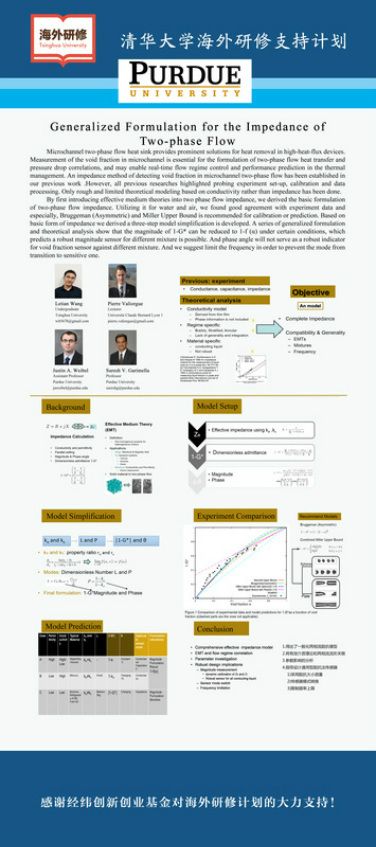Generalized Formulation for Impedance of Two-phase Flow.
Founded by Purdue Cooling Technology Research Center (CTRC) and Tsinghua Spark Program.


Microchannel two-phase flow heat sink provides prominent solutions for heat removal in high-heat-flux devices. Measurement of the void fraction in microchannel is essential for the formulation of two-phase flow heat transfer and pressure drop correlations, and may enable real-time flow regime control and performance prediction in the thermal management. An impedance method of detecting void fraction in microchannel two-phase flow has been established in our previous work.
However, all previous researches highlighted probing experiment set-up, calibration and data processing. Only rough and limited theoretical modeling based on conductivity rather than impedance has been done. A genralized formulation is absent, therefore hindered the further design of sensors.
By first introducing effective medium theories into two phase flow impedance, we derived the basic formulation of two-phase flow impedance. Utilizing it for water and air, we found good agreement with experiment data and especially, Bruggeman (Asymmetric) and Miller Upper Bound is recommended for calibration or prediction. Based on basic form of impedance we derived a three-step model simplification is developed. A series of generalized formulation and theoretical analysis show that the magnitude of 1-G* can be reduced to 1-f (α) under certain conditions, which predicts a robust magnitude sensor for different mixture is possible. And phase angle will not serve as a robust indicator for void fraction sensor against different mixture. And we suggest limiting the frequency to prevent the mode from transition to sensitive one
However, all previous researches highlighted probing experiment set-up, calibration and data processing. Only rough and limited theoretical modeling based on conductivity rather than impedance has been done. A genralized formulation is absent, therefore hindered the further design of sensors.
By first introducing effective medium theories into two phase flow impedance, we derived the basic formulation of two-phase flow impedance. Utilizing it for water and air, we found good agreement with experiment data and especially, Bruggeman (Asymmetric) and Miller Upper Bound is recommended for calibration or prediction. Based on basic form of impedance we derived a three-step model simplification is developed. A series of generalized formulation and theoretical analysis show that the magnitude of 1-G* can be reduced to 1-f (α) under certain conditions, which predicts a robust magnitude sensor for different mixture is possible. And phase angle will not serve as a robust indicator for void fraction sensor against different mixture. And we suggest limiting the frequency to prevent the mode from transition to sensitive one
Downloads--Purdue Confidential-For Internal Academic Use Only, No Further Distribution.
| Pre_CTRC_2013_Wang.pdf | |
| File Size: | 2279 kb |
| File Type: | |
| Poster_eng_CTRC_2013_Wang.jpg | |
| File Size: | 3984 kb |
| File Type: | jpg |
